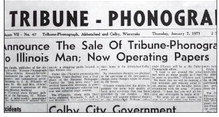Half a century of journalism


The O’Leary family creates newspaper tradition in central Wisconsin
By Ross Pattermann Tribune-Phonograph
For a...


The O’Leary family creates newspaper tradition in central Wisconsin
By Ross Pattermann Tribune-Phonograph
For a...